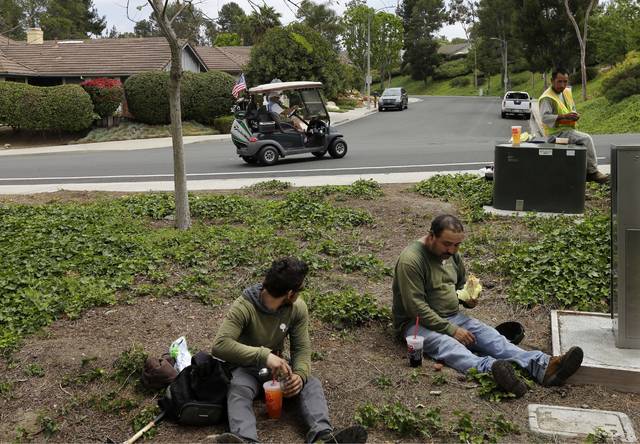Census: Every ethnic, racial group grew, but whites slowest

ASSOCIATED PRESS / 2016
The Census Bureau reported that the median age of Americans — the age at which half are older and half are younger — rose nationally from just over 35 years to nearly 38 years in the years between 2000 and 2016, driven by the aging of the “baby boom” generation.
WASHINGTON >> The United States is growing older and more ethnically diverse, a trend that could put strains on government programs from Medicare to education, the Census Bureau reported today.
Every ethnic and racial group grew between 2015 and 2016, but the number of whites increased at the slowest rate — less than one hundredth of 1 percent or 5,000 people, the Census estimate shows. That’s a fraction of the rates of growth for non-white Hispanics, Asians and people who said they are multi-racial, according to the government’s annual estimates of population.
President Donald Trump’s core support in the racially divisive 2016 election came from white voters, and polls showed that it was especially strong among those who said they felt left behind in an increasingly racially diverse country. In fact, the Census Bureau projects whites will remain in the majority in the U.S. until after 2040.
“Even then, (whites) will still represent the nation’s largest plurality of people, and even then they will still inherit the structural advantages and legacies that benefit people on the basis of having white skin,” said Justin Gest, author of “The New Minority,” a book about the 2016 election.
———
AN AGING NATION
Don't miss out on what's happening!
Stay in touch with breaking news, as it happens, conveniently in your email inbox. It's FREE!
The Census Bureau reported that the median age of Americans — the age at which half are older and half are younger — rose nationally from just over 35 years to nearly 38 years in the years between 2000 and 2016, driven by the aging of the “baby boom” generation.
The number of residents age 65 and older grew from 35 million to 49.2 million during those 16 years, jumping from 12 percent of the total population to 15 percent.
That’s a costly leap for taxpayers as those residents move to Medicare, government health care for seniors and younger people with disabilities, which accounted for $1 out of every $7 in federal spending last year, according to the Kaiser Family Foundation. By 2027, it will cost $1 out of every $6 of federal money spent. Net Medicare spending is expected to nearly double over the next decade, from $592 billion to $1.2 trillion, the KFF reported.
Sumter County, Florida, home of The Villages, a large retirement community, had the highest median age increase, rising from 49 years old in 2000 to 67 years old in 2016. Over that time period, 56 U.S. counties showed a median age increase of 10 years or more.
———
BOOM IN YOUNG PEOPLE
The Census report also showed that children in the U.S. born from 2001 through 2016 were the nation’s fastest-growing age group, with a 6.8 percent jump in the year beginning July 1, 2015. Other age groups either lost or gained population by less than a percentage point, according to the Census Bureau.
That means more demand on taxpayers for schools, bilingual education and accommodations for English language learners, as well as recruiting a corps of educators that reflects the nation’s students. Robert Hull, executive vice president of the National Association of State Boards of Education, said a majority of students in the U.S. are not white, but 82 percent of teachers are white.
“It’s not just the services offered or what we do for the students but who is delivering those services,” Hull said.
The number of English language learners in U.S. public schools was about 4.6 million in the 2014-2015 school year, according to the National Center for Education Statistics.
———
FACE OF A NATION
All race and ethnic groups grew in the year before July 1, 2016, the Census reported.
The Asian population and those who identified as being of two or more races grew by 3 percent each, to 21 million and 8.5 million, respectively. Hispanics grew by 2 percent to 57.5 million. The black population grew by 1.2 percent to nearly 47 million.
The number of non-Hispanic whites grew by only 5,000, leaving that population relatively steady at 198 million of the nation’s 325 million people.
A Pew Research Center analysis of the Census’ current population survey found that white turnout increased in the 2016 election, while black turnout dropped and the non-white share of the U.S. electorate remained flat compared with the 2012 election.
“Any sort of impact on politics may be several decades in the future,” said Mark Hugo Lopez, director of Hispanic research for the Pew Research Center.
California had both the largest number of whites and non-white Hispanics in 2016, 30 million and 15.3 million, respectively.
Texas had the largest numeric increase in both the white and non-white Hispanic populations.
As for the share of a state’s overall population, New Mexico had the highest percentage of non-white Hispanics at 48.5 percent. Maine had the largest percentage of whites, nearly 97 percent.



